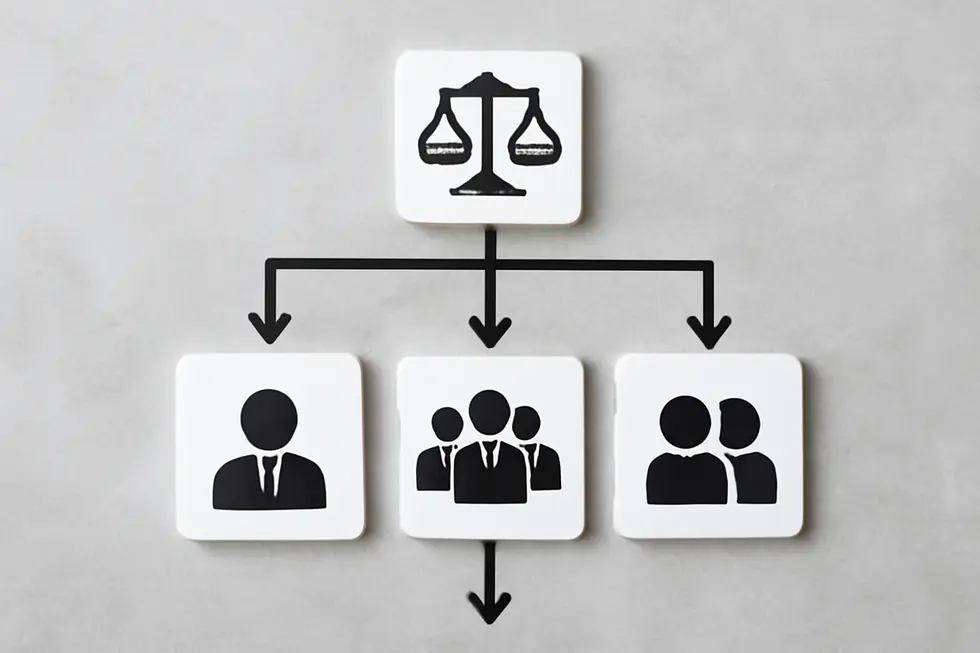Introduction
Selecting the appropriate business entity is one of the most critical decisions a business owner can make. This choice shapes how your business operates, how it’s taxed, and the extent of personal liability you carry. Understanding the nuances between different legal structures empowers entrepreneurs to align their goals with the right protections and benefits. This guide explores three essential facets: the legal structures available, how taxation and liability influence your business, and the formation along with regulatory requirements you must consider. Each chapter builds on the last to provide a holistic understanding crucial for structuring a successful enterprise.
Tables of Contents
Chapter 1: Legal Structures of a Business Entity
- Balancing Liability Protection and Tax Strategies in Business Entities
- Navigating Ownership, Management, and Governance in Business Legal Frameworks
- Balancing Economics and Strategy: How Legal Structures Shape Business Success
Chapter 2: Taxation and Liability Aspects of a Business Entity
- Navigating Tax Strategies and Liability Shields Across Business Entities
- Balancing Liability Shields and Tax Burdens: Key Considerations for Business Entities
- Balancing Tax Benefits and Liability Protection Across Business Structures
Chapter 3: Formation and Regulatory Considerations for a Business Entity
- Navigating Business Entity Choices: Legal Protections, Taxation, and Operational Impacts
- Strategic Jurisdiction Choice and Filing Mechanics: Shaping Compliance and Tax Profiles in Business Entity Formation
- Sustaining Business Integrity: Navigating Continuous Compliance, Governance, and Regulatory Duties
Chapter 1: Legal Structures of a Business Entity

1. Balancing Liability Protection and Tax Strategies in Business Entities
Balancing Liability Protection and Tax Strategies in Business Entities
Choosing a legal structure critically shapes both liability exposure and tax obligations for a business. Sole proprietorships and partnerships leave owners with unlimited personal liability, risking personal assets to settle business debts or legal claims. In contrast, limited liability companies (LLCs) and corporations form separate legal entities, insulating owners’ personal assets from business liabilities. LLCs blend this protection with flexibility, allowing members to choose whether the entity is taxed like a partnership, sole proprietorship, or corporation. Corporations offer robust liability shields but come with varied tax treatments: C corporations face double taxation on profits and dividends, while S corporations avoid it by passing income directly to shareholders under specific IRS rules. This tax flexibility affects cash flow, investment opportunities, and long-term planning. Additionally, corporations entail more formalities and administrative complexity compared to LLCs or sole proprietorships, which may impact ongoing compliance costs. Selecting the optimal structure requires weighing the degree of liability protection desired against tax implications and management preferences. For deeper insights into protecting your business brand within these frameworks, consider exploring strategies for legally protected brand trademarks.
For tailored advice, consulting legal and tax professionals ensures the chosen structure aligns with evolving business goals and regulatory demands.
2. Navigating Ownership, Management, and Governance in Business Legal Frameworks
The structure of ownership, management, and governance fundamentally shapes how a business operates under its legal form. Ownership defines who holds stakes—ranging from a single individual in sole proprietorships to multiple shareholders in corporations. This ownership influences the degree of control and responsibility over the enterprise. Management refers to those directing day-to-day operations, which can be the owners themselves in simpler forms like partnerships or delegated to appointed officers in corporations. Governance involves the formal or informal systems guiding decision-making and oversight. For sole proprietorships and partnerships, governance is usually informal, relying on personal agreements and direct oversight by owners. LLCs introduce flexibility by permitting members to govern based on an operating agreement, balancing control and protection. Corporations operate with a more structured governance model: shareholders elect a board of directors responsible for broad strategic decisions, while hired officers handle operational management. These distinctions affect liability, as owners in sole proprietorships and partnerships bear unlimited personal risk, whereas members or shareholders in LLCs and corporations enjoy limited liability protections. This complex interplay between ownership rights, managerial authority, and governance frameworks aligns closely with business goals, influencing long-term viability and operational efficiency. For entrepreneurs seeking a comprehensive overview, resources like Wise Business Plans offer detailed guidance on these structural choices.
3. Balancing Economics and Strategy: How Legal Structures Shape Business Success
The legal structure of a business entity fundamentally influences its economic realities and strategic trajectory. Economically, it determines tax treatment, liability exposure, and capital availability. Sole proprietorships provide straightforward taxation but place unlimited personal risk on owners. Partnerships share profits and losses while also sharing liability, requiring trust among partners. Limited Liability Companies (LLCs) offer a hybrid advantage with limited personal liability and pass-through taxation, avoiding the corporate double tax burden. In contrast, corporations shield owners through legal separation but face double taxation, balanced by easier access to venture capital and investor appeal.
Strategically, the choice of structure frames decision-making dynamics, growth capabilities, and risk management. Corporations follow formal governance with stock options to attract investors and scale; LLCs grant management flexibility and customizable profit distribution, appealing to diverse business models. Many enterprises rethink their structures as economic or regulatory climates evolve, aiming for improved tax benefits or operational efficiency. This alignment between economic priorities like tax optimization and strategic goals such as scalability ensures the legal structure is more than formality—it shapes the potential and resilience of the business.
For businesses seeking additional protection for their brand assets, understanding legal structures complements brand trademark and business protection strategies.
More insights on these implications can be found here: https://metrobi.com/blog/business-structures-explained/
Chapter 2: Taxation and Liability Aspects of a Business Entity

1. Navigating Tax Strategies and Liability Shields Across Business Entities
The taxation landscape of a business entity hinges on its legal form, profoundly shaping financial outcomes and liability protection. For example, S-Corporations leverage pass-through taxation, where income bypasses corporate tax and flows directly to owners’ personal returns. This mechanism allows owners to pay themselves a salary subject to payroll taxes while receiving remaining profits as distributions, potentially reducing self-employment taxes. However, loss deductions in S-Corps are confined by IRS limits on shareholder basis. Limited Liability Companies (LLCs) mostly default to pass-through taxation as well, blending partnership and corporate features. Single-member LLCs report profits on Schedule C, whereas multi-member LLCs file partnership returns, passing income and losses through to members. LLCs also enjoy flexibility, electing C-Corp or S-Corp status for tailored tax advantages. Conversely, C-Corporations are subject to double taxation: profits are taxed at the corporate level, and dividends to shareholders face personal taxes. Despite this, C-Corps can benefit businesses targeting reinvestment or capital growth due to structural advantages. Recent legislation like the One Big Beautiful Bill Act (OBBBA) of 2025 further shapes choices by extending the Qualified Business Income deduction for pass-through entities and enhancing depreciation benefits, influencing optimal entity selection. Each structure balances tax treatment with liability protection, and understanding these nuances is essential for aligning with strategic business goals. For insights on how choice of entity affects broader protections, explore the detailed LLC vs trademark considerations.
More detailed guidance on tax implications and compliance updates can be found here: https://www.onedegreecapital.com/blog/business-entity-structure-tax-implications
2. Balancing Liability Shields and Tax Burdens: Key Considerations for Business Entities
Choosing the right business entity profoundly influences both liability protection and tax responsibilities. Limited Liability Companies (LLCs) offer significant safeguards by legally separating members’ personal assets from business obligations. They also enjoy versatile tax treatment, defaulting to pass-through taxation while retaining the option to be taxed as corporations, enhancing tax planning flexibility. Corporations, particularly C corporations, provide the strongest liability shield since shareholders, directors, and officers are insulated from personal financial risk. This benefit, however, comes with double taxation, where profits are taxed at the corporate level and again as shareholder dividends. S corporations blend corporate liability protection with pass-through taxation but require compliance with strict IRS requirements, including limitations on shareholders and stock classes. Partnerships present a more varied picture: general partnerships expose owners to unlimited personal liability, whereas limited partnerships and limited liability partnerships afford varying degrees of liability safety. Tax-wise, partnerships generally use pass-through taxation, passing income directly to partners’ personal returns. Ultimately, the decision hinges on weighing liability exposure against tax treatment and administrative demands, tailoring the structure to match business goals and risk tolerance. For entrepreneurs seeking deeper insights on protecting their business identity, understanding how trademarks interplay with these entities can be invaluable, as explored in this guide on trademark protection for businesses.
3. Balancing Tax Benefits and Liability Protection Across Business Structures
A thorough comparison of business entities reveals how taxation and liability form critical decision points for entrepreneurs. Sole proprietorships and partnerships offer straightforward pass-through taxation where income is reported on personal returns, but come with unlimited personal liability, exposing owners’ assets to business risks. Conversely, C corporations create a distinct legal entity that shields owners from personal liability, yet subject their profits to double taxation—once at the corporate level and again on dividends. S corporations mitigate this by allowing income to pass through to shareholders, eliminating double taxation while maintaining liability protection. However, S corporation owners must balance tax savings with the requirement to pay themselves reasonable salaries subject to employment taxes. Limited Liability Companies (LLCs) stand out by combining liability protection with unmatched tax flexibility; they can elect to be taxed as sole proprietorships, partnerships, or corporations, enabling tailored strategies as businesses evolve. This unique adaptability, alongside the strong personal asset protection offered by LLCs and corporations, often makes them preferable for businesses prioritizing both tax efficiency and risk management. For those navigating the intricacies of business entity selection, consulting with professionals familiar with tax and legal nuances remains essential. More insights on protecting business interests can be found in resources about brand and trademark protection. For comprehensive tax guidance, refer to the Internal Revenue Service (IRS) resources (2025).
Chapter 3: Formation and Regulatory Considerations for a Business Entity

1. Navigating Business Entity Choices: Legal Protections, Taxation, and Operational Impacts
Choosing the right business entity requires carefully balancing legal liability, tax implications, and operational needs. Sole proprietorships and general partnerships offer simplicity but expose owners to unlimited personal liability. Limited partnerships add investors with limited risk but impose formal registration and management distinctions.
Limited Liability Companies (LLCs) blend flexibility with liability protection, allowing members to shield personal assets while choosing their preferred tax classification—often benefiting from pass-through taxation to avoid double taxation. LLCs also offer adaptable management structures tailored to the owners’ preferences.
S corporations provide liability protection and pass-through taxation but come with strict eligibility rules, such as limited shareholders and a single stock class. Conversely, C corporations allow unlimited shareholders and stock classes, ideal for raising capital, yet profits face double taxation at corporate and shareholder levels.
Formation involves registering with the state and complying with varying formalities: corporations require bylaws and documented meetings, whereas LLCs benefit from operating agreements that clarify governance. These legal and regulatory factors affect both startup ease and ongoing administrative responsibilities.
Selecting a business entity shapes not just legal risk and tax outcomes, but also how the business will operate daily and attract investment. For detailed insights on protecting your business identity and compliance, review this comprehensive guide on brand trademark business protection.
More details at https://metrobi.com/blog/business-structures-explained/
2. Strategic Jurisdiction Choice and Filing Mechanics: Shaping Compliance and Tax Profiles in Business Entity Formation
The selection of jurisdiction and the filing process are fundamental to establishing a business entity’s legal identity, shaping both its compliance burden and tax responsibilities. Jurisdictions differ widely in regulatory demands, fees, and tax regimes, making this choice a strategic decision rather than a mere formality. Forming an entity in a state other than its primary place of business can lead to costly duplicate filings and heightened compliance complexity. Each entity type—be it an LLC, C-corporation, or S-corporation—requires submitting specific documents tailored to its legal and tax structures, such as articles of incorporation or IRS forms for tax elections. These filings must explicitly state the governing law and jurisdiction to prevent ambiguity that could result in legal disputes or compliance lapses. Furthermore, tax impacts vary drastically depending on jurisdiction and entity classification, influencing whether income faces double taxation or benefits from pass-through structures. Businesses operating across state lines must address additional filings, such as foreign qualifications or entity conversions, introducing further complexity. Engaging legal and tax advisors during this stage is crucial to align formation choices with business goals and optimize regulatory and tax outcomes. For more on legal protections that support your business identity, consider exploring detailed guidance on brand trademark business protection.
3. Sustaining Business Integrity: Navigating Continuous Compliance, Governance, and Regulatory Duties
Sustaining Business Integrity: Navigating Continuous Compliance, Governance, and Regulatory Duties
Once a business entity is formed, ongoing compliance and governance responsibilities become essential pillars supporting its legal and operational standing. Maintaining proper documentation like Articles of Incorporation or Organization, along with bylaws or operating agreements, forms the framework for internal management and dispute resolution. States commonly mandate annual or periodic reports updating ownership, management details, and registered addresses; failure to comply risks fines or suspension.
Tax obligations permeate every business type, requiring federal EIN registration and state-level filings aligned with the entity’s tax classification. Moreover, industry-specific licenses and permits demand regular renewal to remain valid, underscoring the importance of diligent regulatory monitoring. Staying current with evolving laws—including data protection regulations—helps prevent legal pitfalls and supports risk management.
Periodic governance reviews ensure the business remains aligned with its strategic objectives, sometimes necessitating amendments to foundational documents or structural changes. Engaging legal counsel throughout this process streamlines compliance management and fortifies the entity’s stability against legal risks.
For comprehensive stewardship, businesses operating across multiple jurisdictions must adopt tailored compliance systems and assign dedicated accountability roles, ensuring no detail is overlooked. This continuous vigilance, integrating governance, taxation, regulatory obligations, and legal oversight, upholds the integrity and longevity of the business.
For further insights on safeguarding intellectual assets within business structures, explore the benefits of copyright registration for your business.
[1] State corporate formation and maintenance requirements
Final thoughts
Selecting the right business entity is foundational to your company’s success, defining how it operates legally, pays taxes, and manages risk. By first understanding the various legal structures, you establish the core identity of your business. Navigating taxation and liability considerations ensures you balance financial efficiency with robust personal protection. Finally, mastering formation requirements and regulatory compliance cements your business’s legitimacy and ongoing viability. With this comprehensive insight, business owners are empowered to make informed decisions, positioning their enterprises for sustainable growth and resilience in an increasingly complex commercial landscape.
Get your trademark today! Thousands have protected their brand by filing a trademark. What are you waiting for? Start your trademark application!
About us
The globe’s top website for registering trademarks and safeguarding your brand, name, logo, or slogan.







